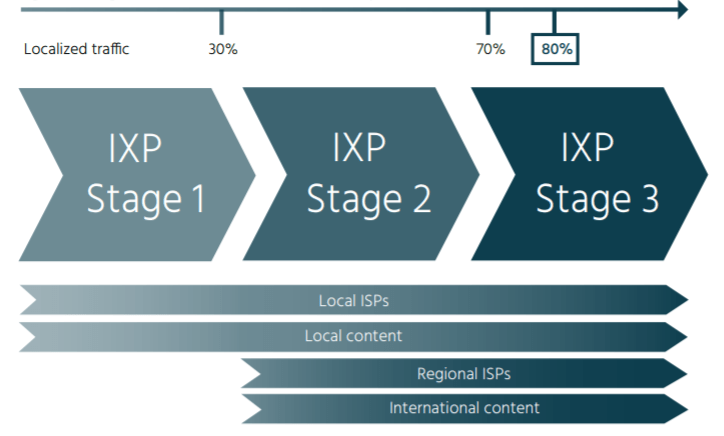Author: Michael Kende
Executive Summary
In 2010, the Internet Society’s team in Africa set an ambitious goal that 80% of African Internet traffic would be locally accessible by 2020.
Internet Exchange Points (IXPs) are key to realizing this goal in that they enable local traffic exchange and access to content. To document this role, in 2012, the Internet Society commissioned a study to identify and quantify the significant benefits of two leading African IXPs at the time: KIXP in Kenya and IXPN in Nigeria. The Internet Society is pleased to publish this update of the original study. In it, we highlight the significant advances made in both countries since 2012 and provide specific recommendations for all countries seeking to strengthen their Internet ecosystem and Internet communities.
The rapid pace of Internet ecosystem development in both Kenya and Nigeria since 2012 underscores the critical role that IXPs and the accompanying infrastructure play in the establishment of strong and sustainable Internet ecosystems.
This development produces significant day-to-day value—the present COVID-19 crisis magnifies one such benefit in the smooth accommodation of sudden increases of traffic due to the unprecedented increase in reliance on the Internet since social distancing and lockdowns began.
Figure 1. Stages of Internet Ecosystem Development

In 2012, in both Kenya and Nigeria, approximately 30% of each country’s traffic was localized. The Internet Society refers to this as Stage 1 Internet ecosystem development, at the cusp of moving into Stage 2 (Figure 1). Each country possessed a strong base for growth, including an existing IXP that was wellmanaged and trusted by local stakeholders. Both countries had static international content available via a Google Global Cache, but no other locally available content. However, each had the necessary foundation of trust and collaboration and the corresponding Internet infrastructure to grow as a hub.
Today, both countries have reached Stage 2 of development, with nearly 70% of traffic localized— and they are poised to move to Stage 3. The growth of the IXPs in each country was exponential, as were the cost savings from exchanging traffic locally rather than using expensive international transit. In Kenya, KIXP grew from carrying a peak traffic of 1 Gigabit per second (Gbps) in 2012 to 19 Gbps in 2020, with cost savings quadrupling to USD six million per year. In Nigeria, IXPN grew from carrying just 300 Megabits per second (Mbps) to peak traffic of 125 Gbps in 2020, and the cost savings increased forty times to USD 40 million per year.
Getting to this point meant following a systematic path of stakeholder relationship building and infrastructure development. The IXPs transformed into multisite and multicity IXPs with at least one node in a carrier-neutral data center, while maintaining their roles in developing and sustaining trust and collaboration among their members. Each IXP also dropped mandatory peering requirements to encourage new members to join and make selective peering agreements. As a result, all of the large international content providers added at least one edge cache in the country, and many also added a point of presence (PoP). The respective governments also played a role by developing the Internet sectors and adopting data-protection policies, thereby reinforcing an environment of trust and welcoming further local-content hosting.
Looking ahead
Progressing into Stage 3 of development and achieving the ITE program’s goal of 80% of African Internet traffic being locally accessed will require a number of recommended actions, which will benefit the individual stakeholders as well as the broader ecosystem.
- Awareness of the benefits of local content hosting and peering at the IXP among a broad range of stakeholders must be raised, which can be achieved via targeted capacity building and information exchange, led by, or with the participation of the IXPs.
- In particular, local content developers who currently host their content outside the country, should host it inside the country to benefit from lower latency and thereby also increase local traffic.
- In addition, smaller Internet service providers (ISPs) should connect to their local IXPs in order to widely peer with other members and thereby increase the efficiency of their interconnections.
- Aggregation of demand for backbone capacity and local content hosting can help lower costs for smaller ISPs and local content developers respectively, to help enable them to connect to their local IXPs.
- Domestic backbone infrastructure must also extend beyond the main landing point for submarine cables and main population center into other population centers, to further lower the cost of exchanging traffic and accessing content locally.
- Finally, an environment of trust and collaboration is key to the successful growth of any technology infrastructure. Stakeholders must communicate and connect as equals, working together toward common stated goals and outcomes.
The Internet Society offers this history of positive steps in Kenya and Nigeria, as well as these recommended actions (page 29), as a blueprint for other African countries to develop and strengthen their Internet ecosystems. Together, as countries began to localize increasing amounts of content, the 80/20 goal of the Internet Society and African Internet community will be realized.
